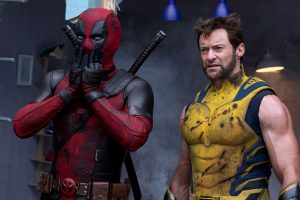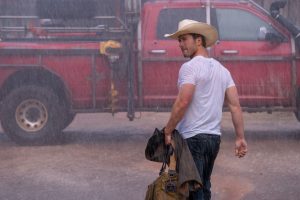Reviews include Deadpool & Wolverine, Doubles, and Mountain Queen: The Summits of Lhakpa Sherpa.
TFCA Friday: Week of July 14
July 14, 2023

Welcome to TFCA Friday, a weekly round-up of film reviews and articles by TFCA members.
In Release this Week
Afire (dir. Christian Petzold)
“With the seaside setting and the youthful characters, Petzold’s film feels very much like the French Eric Rohmer’s youth innocence youth comedies like The Green Ray (Le Rayon Vert) and Pauline at the Beach (Pauline a la Plage), but only much more serious,” says Gilbert Seah at Afro Toronto.
“[Petzold’s] latest, Afire, is his take on the ever-popular summer coming-of-age movie. Accessible and witty with an easy naturalism, Afire is unburdened by the political and historical context of his earlier films, set in an environment of young people eating outdoor meals, shifting romantic arrangements and lots of table talk,” writes Liam Lacey at Original Cin. “On an obvious level, it’s a character study of the artist as an insufferable young prig, a type that, as Petzold no doubt knows, is familiar to the point of cliché. But as the film unfolds, and boldly shifts tone, the character suggests the larger theme of struggling to stay humane in a broken world.”
“The environment is ripe for easy, countryside pleasure – a potent mix of sun and sex. Yet the retreat is threatened by two unwanted guests, of a sort,” notes Barry Hertz at The Globe and Mail. “The first is Leon’s caustic self-absorption, large and overwhelming enough to be corporeal, with the writer so tormented by his latest novel that he thinks himself both above his companions and like the biggest failure in the world. The second is the threat of forest fires, which are gradually encroaching the surrounding countryside. Tensions flare, frustrations boil, and the heat, both metaphorical and literal, is dialled up when Leon’s literary editor arrives to go over his new draft.”
Bird Box Barcelona (dir. Alex and John Pastor)
“Bird Box Barcelona is a follow-up or remake or less likely a sequel, depending on how one wants to look at it, to the highly successful 1985 Sandra Bullock dystopian vehicle Bird Box,” notes Gilbert Seah at Afro Toronto. “More religion is brought into the plot (Is Good saving the world or destroying it?) and there are more expansive action set pieces that are done with CGI.”
The Deepest Breath (dir. Laura McCann)
“Visually stunning, The Deepest Breath will expose many to this extreme form of human endurance. Given that the likes of the latest Avatar blockbuster incorporate free diving elements, it’s clear there’s a hunger to live vicariously through such endeavours,” notes Jason Gorber at POV Magazine. “While the telling of Stephen and Alessia’s story is a sometimes superficial one, there’s still enough moments that plunge into the deeper depths and allow viewers to experience the rush of the journey into the abyss.”
“The free diving segments are stunning and are as mesmerizing as they are scary, many scenes shrouded by darkness owing to the lack of light at great ocean depths,” writes Gilbert Seah at Afro Toronto. “Also educational is the subject of lung collapse, a danger facing most divers that can often cause them to back out during a dive.”
The League (dir. Sam Pollard)
“Pollard is a brilliant editor and producer, who came to prominence working with Spike Lee on the docs When the Levees Broke and 4 Little Girls, is a master in finding and assembling footage in order to tell a compelling story. Along with Questlove…the film is a treat, weaving indelible images from the Thirties and Forties of crowds entering parks, working in factories, and fighting in World War II with jazzy tunes extolling the baseball prowess of big stars like the homerun hitting Josh Gibson, the lanky maverick Satchel Paige and the man who finally broke the racial colour barrier in 1946, Jackie Robinson,” writes Marc Glassman at POV Magazine. “The filmmakers make it clear that the baseball played in the Negro Leagues was different from that of the stodgy all-white Major Leagues: faster, more improvisatory, filled with stolen bases, flashy defensive plays and tricky strategies.”
The Miracle Club (dir. Thaddeus O’Sullivan)
“[N]othing in The Miracle Club is rewriting cinematic storytelling despite having multiple narrative layers. But director Thaddeus O’Sullivan’s gentle film, with its sweeping vistas, top-drawer cast, and groovy period costumes is delightful, occasionally very humorous, and a reminder that life really does happen at its most profound when we are busy doing other things,” says Kim Hughes at Original Cin. “Amid fanciful summer tentpole blockbusters and superheroes, there may be no better reason to see it.”
“Thaddeus O’Sullivan gathers a remarkable cast for The Miracle Club. The gently dramatic tale stars Laura Linney, Kathy Bates, Agnes O’Casey, and the beloved Maggie Smith as Irish villagers and in Linney’s case, as Chrissie, an American returning home to Ballyfermot for her estranged mother’s funeral,” writes Anne Brodie at What She Said. “A charming time capsule of rural life in 1960s Ireland, and a tale of forgiveness and love.”
Mission: Impossible – Dead Reckoning Part One
(dir. Christopher McQuarrie)
“The whys and wherefores of Cruise’s death wish aren’t some grand mystery begging to be unlocked,” observes Barry Hertz at The Globe and Mail in a paean to Cruise’s stardom and death-defying stunts. “The man has steadily and proudly branded himself as the movie world’s most passionate advocate for bigger-than-big entertainment. And while walking along this path to eventual on-screen martyrdom, Cruise has correctly intuited that what gets people off their couches and inside a multiplex is the titillation of an explosive but risk-free encounter with death itself. Cruise puts his body on the line because he knows that doing so will lift the industry’s bottom line. (And his own, naturally.) The day that Tom Cruise dies – and it will happen, eventually and stupendously – might be the day that movie theatres die, too.” Hertz also ranks the Mission: Impossible flicks with notes on where to see them, and ranks the full Cruise-ography. For more insight on Cruise control, he chats with Dead Reckoning director Christopher McQuarrie about his long collaboration with the star and what it means to say no to Tom Cruise: “We always come up with things that are too complex to execute. We usually discover this after we’ve committed,” McQuarrie tells Hertz. “Rather than back out, we push on. In Africa, while shooting a sequence for Dead Reckoning Part Two, he came up with an idea that I told him could not be done, simply because no camera rig existed that could capture it. By that afternoon, our team had built it.”
“Cruise has garnered a reputation of one-upping himself with each consecutive film. One of the most iconic pop culture moments of the 1990s was Cruise’s upside-down infiltration of a Langley vault via ropes and cables from a ceiling in the first film. While seemingly simple but technically complex for the actor to pull off, that stunt began a chain reaction of greater stunts that the franchise has come to be known for, especially with director Christopher McQuarrie at the helm,” writes Rachel West at the Alliance of Women Film Journalists. “This time around, Cruise literally throws himself off a cliff on a motorbike in a highly publicized stunt that is just one of many jaw-dropping moments in the finished film. Part of what makes this franchise so successful is not just Cruise’s willingness to attempt the impossible, but the reliance on practical, in-camera stunts and effects wherever possible.”
“Dead Reckoning, my new M:I favourite and the summer’s biggest blockbuster…gives us more action and more reason to stop caring about the who, what, where and why of it all. Just try to relax and enjoy the absurd real-life stunts of Cruise/Hunt and his fellow lunatics as they defy physics, gravity and logic with increasingly dangerous action set pieces, including the mother of all motorcycle leaps,” says Peter Howell at the Toronto Star. “Dead Reckoning first and foremost belongs to its most dedicated player, actor/producer Cruise, who continues to insist on doing his own stunts, even as they become ever more threatening to life and limb.”
“[T]he execution of the premise feels a bit goofy — but that is arguably part and parcel to using a program as a villain,” notes Rachel Ho at Exclaim!. “All that said, let’s be real — we don’t go to watch Mission: Impossible movies for the plot (even though the storylines in the most recent films have been particularly strong). Every single one of the action setpieces in Part One is tremendous. From the car chases to the hand-to-hand combat scenes, Cruise and McQuarrie more than deliver on creating a high-octane, thrilling action film for the summer.” Ho also picks the top five M:I stunts, including a doozy from Dead Reckoning: “The centrepiece of Dead Reckoning Part One, it’s mystifying seeing a motorbike crash into a stony abyss as Cruise free falls across (and seemingly towards) the jagged cliffs, pulling his parachute just in time for a safe landing.”
“As the film reaches its breathtaking conclusion, Ethan and Grace have to deal with a classic disaster, the runaway train plunging towards certain doom,” says Marc Glassman at Classical FM. “McQuarrie and his admirable team have devised an extended sequence in which one train car after another falls down a vertiginous Swiss cliff: it’s absolutely brilliant. As Ethan and Grace desperately leap from one car to another, the situation becomes crazier and crazier—especially a sequence where the kitchen eventually explodes all too close to them. It is the funniest and scariest scene ever made on a train. I never thought I’d say this—it’s better than the action scenes in Buster Keaton’s The General, one of the finest films ever made.”
“The opening two acts of more or less static, multi-face exposition, followed by long car chases in Rome and boat-and-bridge chases in Venice would have benefited from a fastidious editor’s cuts. The third act more than makes up for lost momentum with its stupendous stunts that Tom Cruise reportedly rehearsed for months, and the motorcycle cliff-diving behemoth, nailed, cameras rolling, in 7 takes. OMG,” gasps Anne Brodie at What She Said. “That shock trauma silent scene flying into the Alpine vastness was the first order of shooting for obvious reasons. So we tip our hat to the greatest risk taker in Hollywood history, Mr. Cruise, who long ago surpassed early practitioners Harold Lloyd and Buster Keaton.”
“What Dead Reckoning does so well, however, is to crank up the torque on just about every scene. Indiana Jones features a fight on top of a moving train? Mission: Impossible does that too, then dangles said train over the edge of a blown-up bridge, letting each car swing precariously for a while before falling to its doom. It goes on forever, and I never wanted it to end,” raves Chris Knight at the National Post. “[Cruise] jumps a motorcycle off the edge of a cliff. And gives us the best damned summer popcorn blockbuster action-thriller movie of 2021. In 2023”
“[G]ets my vote for Best Action blockbuster of 2023,” declares Gilbert Seah at Afro Toronto.
“Thematically, this film couldn’t arrive at a better time. There have been countless movies about rogue AIs terrorizing humanity, but all these films came before the technology provided a plausible threat,” notes Victor Stiff at That Shelf. “Now, as programs like ChatGPT are finally out in the world and accessible to everyone, the potential dangers presented by advanced AI aren’t just the stuff of campy sci-fi flicks. Dead Reckoning’s depiction of weaponized AI is a disturbing wake-up call that comes across as horrifying as a chemical weapon attack.”
At That Shelf, Pat Mullen chats with veteran Canadian actor Henry Czerny about reprising his role as Kittridge and returning to the M:I franchise after the 1996 original: “[M]y backstory was that Kittridge had gone back [to the IMF] because he was schooled by Ethan early on,” Czerny says. “What he’s learned—as any good documentarian, I think, learns—is that the film you think you’re shooting is where you start, and the film you end up shooting can be something quite different. Kittridge walks away from all of that homework, if you will. He’s more grave, more aware of how the world works, and not necessarily thrilled with how the world is working.”
Mr. Car and the Knights Templar (dir. Antoni Nykowski)
“Mr. Car and the Knights Templar is unfortunately a poor man’s version of Indiana Jones. The film is also a bit violent (example: a head sizzling birth under a hot lamp at the film’s start), though little blood and gore is shown,” sighs Gilbert Seah at Afro Toronto. “Special effects are possible at best.”
Once Upon a Time in Uganda (dir. Cathryne Czubek, Hugo Perez)
“Doc co-directors Cathryne Czubek and Hugo Perez follow American Alan Hofmanis, a New York film programmer, publicist, and filmmaker as he flies to Uganda to see the team in action. He partners with Isaac, sells his NYC apartment and car and gives his mother his cat, and stays. Alan hopes to take Wakaliwood global and what happens over the next few years is just as astounding as the films. Strap yourselves in and dodge the fake bullets. This is FUN,” advises Anne Brodie at What She Said.
Quicksand (dir. Andres Beltran)
“Quicksand contains a few genuine scary moments, as the impending snake attack segment,” writes Gilbert Seah at Afro Toronto. “But there the film should also show the couple trapped in quicksand standing still with the head level above the fluid. But in truth, most of the time a person would be at waist level if trapped. There are more things to be unlearned about quicksand in this sorry case of a horror movie.”
Subterranean (dir. Francois-Xavier De Ruydts 🇨🇦)
“Taking audiences into the caves with both the Bisaro Anima and Argo teams, one feels every claustrophobic step through the narrow passageways the two teams’ travel,” says Courtney Small at POV Magazine. “Whether using drones to comb through unchartered depths underwater, quietly observing the process of ‘bolt climbing,’ or learning about how cavers handle bodily waste to ensure the sanctity of the shared environment, De Ruydts’ documentary makes the audience feel as if they have earned their amateur spelunker status.”
Umberto Eco: A Library of the World (Dir. Davide Ferrario)
“Ferrario’s film feels like a random ramble through a well if eccentrically stocked second-hand bookshop,” notes Chris Knight at Original Cin. “And Eco himself discusses his love of imaginary places, unfinished works, non-existent languages, and self-published books, like the one featuring letters of correspondence to the Pope and Albert Einstein (none of them answered) or the guy who rewrote Alesandro Manzoni’s three-volume 1828 novel The Betrothed using shorter words to save time and space. What emerges is a portrait of a thinker forever questing, contemplative, and opinionated and engaging and funny. A writer and most importantly, a reader, and one who will likely make you want to cancel your next movie date in favour of something more literary.”
“There are new books, classics, low-brow books, esoterica, 500-year-old volumes that look new, older books that look old, ancient drawings charts, curiosities, magic spells, divination, elaborate jokes, the complete Charlie Brown, a big book featuring a glass receptacle on the spine holding dog’s testicles,” notes Anne Brodie at What She Said. “He and his books hold a vast spectrum of what he calls Vegetal knowledge, as opposed to instantly forgettable, not-knowledge of electronica or Mineral knowledge. Eco’s bite-sized, dead-on and entertaining philosophical declarations are a constant and I’ll save them for you to watch. I want T-shirts bearing his slogans.”
“Library of the World imparts the role that libraries and archives play by inviting fellow academics to share their thoughts on the written word,” writes Pat Mullen at POV Magazine. “However, the documentary avoids conventional talking heads interviews in these cases. Instead, Ferrario affords the bookworms theatrical vignettes. The participants share their thoughts as Shakespearean soliloquies and Aaron Sorkin-esque walk-and-talks. The sense of play brings the documentary to life. Moreover, these long takes generally occur in libraries and the Steadicam shots weave around the cases of books to showcase the collective memories that enduring in stacks around the world.”
Unknown: Killer Robots (dir. Jesse Sweet)
“Unknown: Killer Robots is a satisfactorily made doc from Netflix, nothing too fancy or made with extensive research. However, the doc is informative and educational, especially in these times when Artificial Intelligence is all the hype,” notes Gilbert Seah at Afro Toronto.
A major American actors union is set to go on strike. @JustSayRad joins us to discuss what this means for the film and television industry. #writersstrike #actorsstrike #whatnext pic.twitter.com/dVhaVXcfYn
— CTV Your Morning (@YourMorning) July 13, 2023
File Under Miscellaneous: Actors’ Strike, Ukraine on Film
At The Globe and Mail, Johanna Schneller looks at the state of the industry with the strike arriving on the heels of the Emmy nominations: “The other strike sticking point, the threat of AI to writers’ and actors’ work, is racing ahead of how fast we can process it,” writes Schneller. “And the money folks are playing hardball – an anonymous executive told Deadline Hollywood that the suits are willing to keep the writers on strike until they can no longer afford their rent or mortgage payments. Let me reiterate that: People like Netflix chief Ted Sarandos, who made $22-million plus stock options last year, are willing to see writers, most of whom are raggedly middle class, be unhoused.”
At The Globe and Mail, Barry Hertz considers what’s at stake for the movies with SAG-AFTRA going on strike: “[D]ata on just how well movies and shows are performing in the new digital realm is essentially kept under lock and key, so secret that not even the stars or directors of productions often know how many people are watching what they created, and thus how well their success should be financially rewarded,” writes Hertz. “Unless you were running a Fortune 500 company, who would you side with? Would it be someone like Disney CEO Bob Iger, who on Thursday – the day after it was revealed that his contract had been renewed and his annual target bonus raised from $1-million to $5-million – said that SAG-AFTRA is not being ‘realistic’ and that any labour action will ‘have a very, very damaging effect on the whole business’?”
At POV Magazine, Jason Gorber looks at the body of films that capture the unfolding war in Ukraine and offer perspectives of citizens who refused to be defined by tragedy. “The filmmakers making these important new docs share a desire to honour the fundamental aspects of Ukrainian culture, the very thing under attack by an enemy that wishes to erase its uniqueness and batter it into submission. This threat makes these stories more powerful and profound, and the necessity of telling them more urgent,” observes Gorber. “Whether these works succeed artistically or not may be moot, because they’re trying to tell the stories of a people in crisis, a factor that would seem to trump criticism. That, for now, may be what’s required: to simply tell the story of Ukraine and its people to the world.”
A Festival of Festival Coverage: ICFF Returns, AOD Debuts
At Toronto Franco, Gilbert Seah profiles some of the films screening at Lavazza Italian Contemporary Film Festival, including Diary of Spices: “Luca and Andreas belong to two different worlds, art and cooking, and they have two opposing characters: the first is shy and awkward, the second is self-confident and worldly. Luca is looking to expand his horizons with wealthier clients while maintaining his restaurant,” writes Seah. “He also discovers a rare white caraway spice, the plant he had believed extinct, Thisstory is intercut with another, a doggedly obsessed detective over a child trafficking case, in which he is impersonally involved owing to his own missing daughter. The stores are eventually connected in this taut and well paced thriller worthy of a Claude Chabrol murder suspense thriller.”
At Original Cin, Jim Slotek previews the new Art of Documentary Festival, which features a film challenge and master classes. He breaks down some of the films made within the 24-hour timeframe, including Late Frost: “Though Late Frost was easily my favourite, there are more One Day entries in completion, including a couple of Canadian ones – Jack the Bass is a frenetically edited short profile of 21-year-old Toronto jazz bassist Jack Johnston, whose love affair with the instrument began at age 14 when he heard his first Jaco Pastorius album,” writes Slotek. “In a flurry of images, Jack the Bass takes us through the TTC, rehearsals with bandmates, concert scenes and busking at Dundas Square.”
https://youtu.be/i5U-w1yL4r0
TV Talk/Series Stuff: The Bear Roars Again
At What She Said, Anne Brodie reports on the return of The Bear: “The close-quartered portrait of a diner and the people who give it life launches its second season and as expected, it’s terrific,” notes Brodie. “One of the best short-form series around lifted by superb writing, performances, and a deep sense of energy and immediacy.” For something lighter, there’s Survival of the Thickest starring Michelle Buteau: “Silly stuff but it’s a joy to watch her work. Full of good intentions and smart, we hope the best comes her way, whatever that may be,” says Brodie. The Afterparty, meanwhile, “is a truly iconoclastic and witty series in a sea of murder mystery shows and absolutely essential viewing, and the return of Black Mirror, Brodie says, “freaks me the heck out.”



